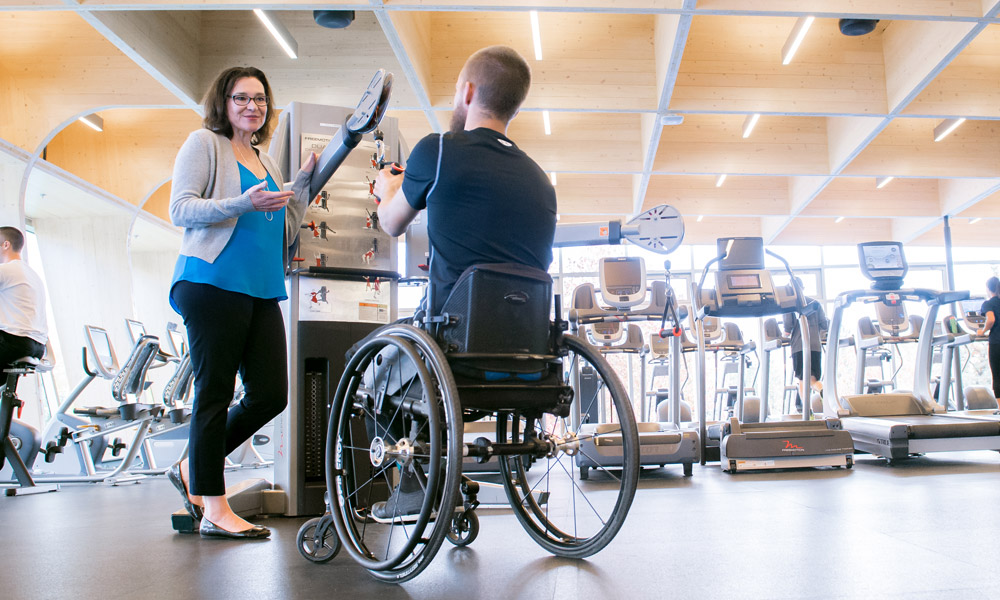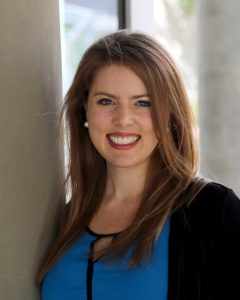
KATHLEEN MARTIN GINIS SPEAKS WITH INCREDIBLE PASSION as she discusses the growing impact of research on spinal cord injuries.
Affecting more than 85,000 Canadians, spinal cord injury (SCI) has been classified as one of the greatest survivable catastrophes experienced by a human. Although spinal damage is often irreversible, new research breakthroughs are helping to minimize disability after SCI and improve quality of life for those affected.
Led by UBC Okanagan’s Martin Ginis, a professor with the Southern Medical Program and the School of Health and Exercise Sciences, a team of campus researchers are devoted to improving the health and well-being of people with SCI.
“We are in the position to make a real difference,” she says, adding that many have been injured in the prime of their lives.
“A spinal cord injury can happen in the blink of an eye. Falls and motor vehicle accidents are the leading causes in Canada, but an increasing number of cases are the result of non-traumatic causes such as cancer and stroke. Regardless of the cause, an SCi can have a life-long impact.”
Regardless of the cause, spinal damage is a terrible diagnosis.

Read more about Prof. Kathleen Martin Ginis in UBC’s One Great Idea series.
Martin Ginis describes the one great idea that significantly influenced her specific discipline and in turn, transformed how she approaches her work.
Game changer: UBCO researcher Jasmin Ma (PhD Candidate)
SCI Action Canada: Partnership shares strategies with health-care professionals and helps patients live more active lives
Martin Ginis is the founding director of SCI Action Canada, a national alliance of organizations and researchers working to improve physical activity in people with spinal cord injury.
Her research studies are some of the first to highlight the benefits and strategies of getting people with SCI involved in exercise and sport.
“Individuals with SCI are not only faced with physical challenges, they may also struggle with social and psychological issues,” says Martin Ginis, who is also director of the UBC Southern Medical Program’s Chronic Disease Prevention Program.
“Physical activity is a game changer—it improves people’s outlook and abilities.”
“Our guidelines are safe and will have significant fitness and cardiometabolic health benefits for adults with spinal cord injuries.”
For many individuals with SCI, Martin Ginis says it’s not about regaining what they’ve lost but maximizing what they have. Deconditioned muscles can be strengthened and chronic diseases such as obesity and diabetes can be mitigated by physical activity.
She recently worked with an international committee to develop the first evidence-based exercise recommendations specifically for the SCI population.
Martin Ginis says this precision is necessary to prevent cardiometabolic illnesses. Cardiovascular disease is the leading cause of death in adults with SCI, who are also at increased risk for obesity and diabetes relative to the general population.
“We can now say that our guidelines—prescribing a tailored dose of exercise—are safe and will have significant fitness and cardiometabolic health benefits for adults with spinal cord injuries.”

Rob Shaw exemplifies how PhD student research can affect peer mentorship within the SCI community
“Students are the cornerstone of our work,” says Martin Ginis, who is currently mentoring a number of graduate and undergraduate UBCO students.
“They bring enthusiasm, fresh ideas and dedication. They have a chance to make real contributions—to make a difference.”
Making that difference is the driving force that has shown Martin Ginis how some young men and women, initially devastated by their injuries, become independent and return to work and school. She’s seen how exercise has benefitted these difference-makers in the SCI community, many of whom she considers friends and colleagues. Such colleagues as Rob Shaw.
A PhD student mentored by Martin Ginis, Shaw is evaluating the successes and pitfalls of peer-mentorship within the SCI community.
Shaw was a tennis pro prior to an accident where he became partially paralyzed from the neck down. He now divides his time between acing doctoral research and wheelchair tennis competitions. (He is a three-time Canadian Quad Wheelchair Tennis Champion (2015/16/17) and is ranked 14th in the world.)
“I have experienced firsthand the benefits of peer mentoring as both a mentee and mentor,” he says. “This personal knowledge drives my passion for investigating how to maximize the effectiveness of this service.”
“The resources on campus are tremendous and the facilities are top notch. This university has everything an undergraduate and graduate student needs to succeed.”
Shaw is often described as a driven and compassionate role model within and beyond the SCI community.
“Rob inspired me to get involved with SCI research,” says Gabriel Dix, a third-year Human Kinetics student, who will soon be working with Martin Ginis. He approached the professor to supervise his honour’s thesis after hearing Shaw’s anecdotes about peer-mentor research and rediscovery of tennis after his accident.
“I want to help those with disabilities,” says Dix, acknowledging that the close-knit nature of the Okanagan campus has allowed him to collaborate with senior researchers. “The opportunities here are astronomical.”
TYPES OF EXERCISES THAT BENEFIT ADULTS WITH SCI
For fitness and strength:
- At least 20 minutes of moderate to vigorous intensity aerobic exercise twice per week; and
- Three sets of strength training for each major muscle group twice per week.
For cardiometabolic health:
- At least 30 minutes of moderate to vigorous intensity aerobic exercise three times per week.
Shaw agrees: “The number of talented researchers at UBC Okanagan is growing exponentially and because of this the opportunities for students are also increasing. The resources on campus are tremendous and the facilities are top notch. This university has everything an undergraduate and graduate student needs to succeed.”
Collaboration and opportunities to thrive also define doctoral student Jasmin Ma, who is in her last year of graduate school. Originally from a personal training background, Ma became particularly interested in the general lack of availability of physical activity resources for individuals with mobility issues.
Ma worked with more than 300 community members to develop training and intervention strategies for people with SCI. These findings will be consolidated into a toolkit for physiotherapists, who can individualize the knowledge as appropriate.
“From caring for themselves to caring for their family, our research has real-life implications for people with SCI,” says Ma. “We are fully engaged with the SCI community and learning is a two-way street; they learn from us. But equally as important, we learn from them.”
Primary investigators and student researchers alike value and rely on input from the SCI community
“How can I help?” is the first question Heather Gainforth asks before she embarks on a research project.
The assistant professor in UBCO’s School of Health and Exercise Sciences finds this approach provides meaning and relevance to her work. Her end-goal is to improve the quality of research by changing the way it’s done in partnership with people with spinal cord injury.
“Our group is interested in doing research that will improve the quality of lives,” she says, adding this can only be accomplished in partnership with the SCI community.
“As researchers, we are often considered experts, especially when it comes to the scientific process. But expertise comes from many different experiences and isn’t always denoted by the letters ‘P-H-D.'”
“The BC community is amazing. There is an ever-increasing demand for collaboration.”
Gainforth recently partnered with the SCI associations of Alberta, British Columbia and Ontario to evaluate peer mentorship within the community. With the long-term goal of providing guidelines, this research group asks questions such as, “What makes a great mentor?”, What is the best way for mentors to support mentees?, and “How can we train mentors to provide the best support for mentees?”

“Almost every spinal cord injury association across Canada offers a peer mentorship program,” Gainforth says. “We would like to understand what works with the aim of streamlining and expanding our efforts to share new, relevant and applicable knowledge with every affected individual and their families.”
Engaging the end users as equal partners with researchers, a practise called integrative knowledge translation, is Gainforth’s speciality and one that is gaining popularity. Organizations such as the Rick Hansen Foundation, the Michael Smith Foundation for Health Research and ICORD fully endorse this philosophy and are encouraging other investigators to adopt it.
Gainforth strongly believes that integrative knowledge translation is increasingly being considered the gold-standard approach to research, adding that the openness of UBCO’s research community facilitates and strengthens these relationships. She received a Michael Smith Foundation for Health Research Scholar Award to partner with the SCI community to develop integrated knowledge translation guidance for doing research in partnership with the SCI community.
“The BC community is amazing,” she says. “There is an ever-increasing demand for collaboration, which is incredibly exciting.”
SCI Canada’s endorsement from the country’s most road-tested paraplegic suggests a new and better direction forward
Martin Ginis agrees that the community aspect of her work is incredibly rewarding.
“When we first saw the positive impact of physical activity in our small lab, I wanted to be able to share this with the whole SCI community.”
That goal is in motion thanks to ongoing support and collaboration with partners such as legendary Canadian Paralympian and philanthropist Rick Hansen.
“The research we are doing within our SCI group at UBC Okanagan is setting us apart from what others are doing in this area.”

Rick Hansen wheeling in Birdsville in the Australian Outback, 1986. Courtesy, Rick Hansen Foundation
“By applying these guidelines, people with SCI can expect to reach closer to normal health outcomes and lead full and meaningful lives. I am very proud of the work produced by Dr. Martin Ginis and her dedicated teams,” says Hansen.
“With respect to physical exercise,” Martin Ginis says, “the community-engaged research we are doing within our SCI group at UBC Okanagan is setting us apart from what others are doing in this area. It’s an exciting time.
“We can see the impact of our work. Improved fitness can mean the difference between needing a caregiver to tuck you in at night and being able to independently take care of yourself.”
THE REALITY OF SPINAL CORD INJURY (SCI)
 Some facts on SCI in Canada
Some facts on SCI in Canada
- People living with SCI in Canada: 86,000
- Number of new cases of SCI each year: 4,300
- Traumatic SCI occurs most commonly in males between the ages of 20 to 29
Rick Hansen Institute, June 2013